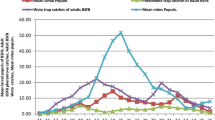Abstract
The feeding habits and infestation of the bitterleaf weevil, Lixus camerunus Kolbe, were investigated in Rivers State, Nigeria. Vernonia amygdalina was the only species preferred for feeding and oviposition by adult L. camerunus, among the species (Talinum triangulare (Jacq.) Wild, Telfairia occidenlalis Hooker fil, Amaranthus hybridus L., Solarium melongena, Capsicum sp., Chromalaena odorata (Eupatorium odoratum) L., Emilia praetermissa L.) associated with V. amygdalina in farms, that were offered. There was a significant correlation between dry weight of foliage consumed and weight of males and females. Initial tunnelling direction by larvae was upwards, but on the death of shoots, larvae reversed direction and moved downwards along old tunnels. However, newly-emerged larvae in leaf petioles, tunnelled downwards to the main branch, before pursuing an upward course. In addition to main tunnels, there were also branch tunnels. There was a significant negative correlation between length of tunnel and stem diameter. There was a significant negative correlation between gall/stem diameter ratio and stem diameter. L. camerunus is widely distributed in the State.
Résumé
Le comportement alimentaire et la mode d’infestation de la feuille amere, Lixus camerunus Kolbe ont ete studies dans l’Etat des Rivieres au Nigeria. La Vernonia amygdalina Del. était la seule espèce préférée par l’adulte L. camerunus pour l’alimentation et l’oviposition et eeci parmi les 8 espèces offertes, Talinum triangulare (Jacq.) Wild, Telfaria occidentalis Hooker fil., Amaranthus hybridus L., Solanum melongena L., Capsicum sp., Chromolaena odorata (Eupatorium odoratum) L., Emilia praetermissa. Il y avait une correlation significative entre le poids sec du feuillage consome et les poids des maies des e femelles. La direction initiale du percement d’un tunnel par les larves etait ascendante, mais une foir le sarment est nort, les larves renversent la direction et tournent de haut en bas. Neanmoins les larves sortant des petioles de la feuille, percent sur la direction descendante vers la branche principale avant de poursuivre leur percement sur la direction ascendante. En dehors des tunnels princip paux il ya aussi des tunnels auxiliaries. Il y avait une correlation significative et negative entre le rapport du diametre galle/tige et diametre tige. L. camerunus est largement repandu a travers l’Etat des Rivieres au Nigeria.
Similar content being viewed by others
References
Akinlosotu T. A. (1977) A check list of insects associated with local vegetables in South Western Nigeria. Res. Bull. Univ. Ife. Institute of Agricultural Research and Training.
Barnes D. J. and Ratcliffe J. (1967) Leaf disk method of testing alfalfa plants for resistance to feeding by adult alfalfa weevils. J. Econ. Ent. 60, 1561–1565.
Dalziel J. M. (1973) The useful plants of West Africa. Crown Agents, London.
Forsythe J. (1966) Agricultural Insects of Ghana. Ghana University Press, Accra.
Golding F. D. (1946) The insect pests of Nigerian crops and stock. Agric. Dept. Nigeria Spec. Bull. No. 4.
Koehler C. S. and Gyrisco G. G. (1963) Studies on the feeding behaviour of alfalfa weevil adults from the Eastern and Western United States. Can. Ent. 56, 489–492.
Lamborn W. A. (1914) The agricultural pests of the Southern Provinces, Nigeria. Bull. Ent. Res. 5, 197–214.
Libby J. L. (1968) Insect pests of Nigerian crops. University of Wisconsin. Coll. of Agric. Res. Bull. No. 269.
Misari S. M. (1981) Insects attacking bitterleaf, Vernonia spp. in Northern Nigeria. A paper presented at the 14th Annual Conference of the Ent. Soc. of Nigeria at the Nigerian Institute for Trypanosomiasis Research, Kaduna.
Okiwelu S. N. (1977) Consumption by alfalfa by larvae and adults of the Egyptian Alfalfa Weevil Hypera bru-nneipennis (Coleoptera: Curculionidae). Ann. Ent. Soc. Am. 70, 622–624.
Peacock A. D. (1913) Entomological pests and problems in southern Nigeria. Bull. ent. Res. 4, 191–220.
Toye S. A. (1974) Bibliography of Entomological Literature in Nigeria (1900-1973). Occ. Pub. Ent. Soc. Nig. No. 19.
Usua E. J. (1969) Preliminary notes on the curculionid beetle Lixus camerunus Kolbe.. Niger. Ent. Mag. 2, 26–30.
Author information
Authors and Affiliations
Rights and permissions
About this article
Cite this article
Okiwelu, S.N., Ndome, C.B. & Ide, Y.F. Insect Pests of Leafy Vegetables in Rivers State, Nigeria: I. Feeding Habits and Infestation of the Bitterleaf Weevil Lixus camerunus Kolbe (Coleoptera: Curculionidae). Int J Trop Insect Sci 9, 557–561 (1988). https://doi.org/10.1017/S1742758400011140
Received:
Revised:
Published:
Issue Date:
DOI: https://doi.org/10.1017/S1742758400011140



